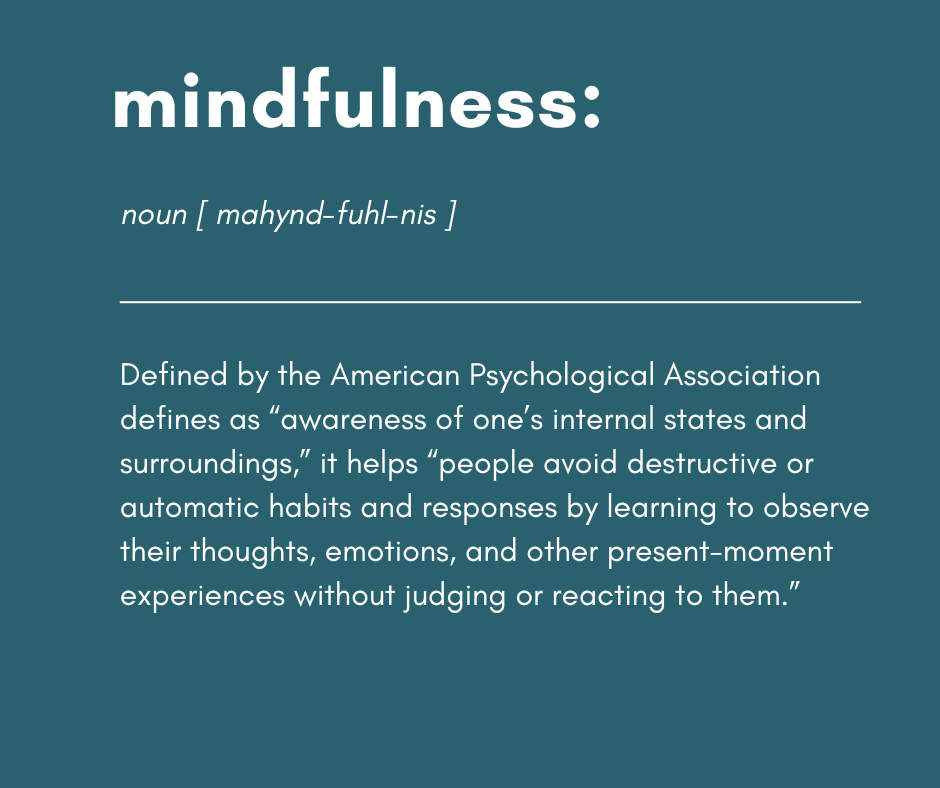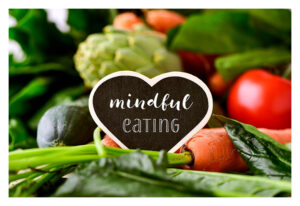 By Katie Defoe-Raymond, MS, RD, CSG, LDN – WestMass ElderCare Registered Dietitian
By Katie Defoe-Raymond, MS, RD, CSG, LDN – WestMass ElderCare Registered Dietitian
Mindful-based eating is an approach to behavior change that encourages a healthy relationship with food through judgement-free awareness and observation of both what is occurring internally in the body around eating and what is happening in the surrounding environment. In addition to supporting healthy eating habits, the idea of mindfulness is also at the heart of other healthy habits and selfcare.
Through those key concepts of awareness and observation, mindful-based eating encourages recognition of internal cues from the body (feeling of fullness or hunger). It also allows for non-judgmental awareness of non-hunger-related stimuli that result in eating, including triggers for emotional or reactive eating. Part of why mindfulness may support behavior change is that it allows for awareness of emotions and how they may contribute to decisions and actions.
This gentle, non-diet approach surrounding food promotes:
- an awareness of self and trust in the body (intuitive eating),
- self-compassion,
- an enjoyment of food by being “present” when eating,
- a reduction of negative feelings toward food by helping people shrug off the idea of “good” versus “bad” foods or being “good” versus “bad” when eating,
- a reduction in feelings of restriction or deprivation.
Mindful eating also supports retraining of unhealthy behaviors around food by allowing for awareness of emotions and how they may contribute to decisions and actions relating to eating. Using this knowledge, people can then work towards disrupting the chain of events contributing to overeating, eating when not hungry, restrictive eating, reactive or emotional eating, etc.
Research shows the benefit of mindfulness-based interventions (MBI) to promote chronic disease management and behavior change. Studies also show MBI may result in healthy weight loss and may be a successful part of the treatment approach for eating disorders, although more research is needed.
Incorporating mindfulness into your eating habits
- Slow down. Sit down when you’re eating.
- Be present for each bite and sip. Avoid distractions. Savor the moment and what you are eating/drinking. Minimize anything that might make it difficult to “be present” when eating. For example, consider turning off the TV and putting away your cell phone.
- Be compassionate and kind to yourself. Keep practicing. Be patient with yourself and the process. Free yourself of past expectations and stereotypes around food, including “good food versus bad food,” “all-or-nothing” mentality, “one last time,” or goals of restrictive eating.
- Observe non-judgmentally. Be inquisitive. How does your food look, smell, feel on your tongue? Is the food salty, sweet, and how does your body react?
- Reflect after eating. Recognize physical reactions that occurred from eating, in addition to your thoughts and feelings surrounding eating and the food.
- Instead of automatically grabbing for a food without thinking, do a scan of your body: any feelings of hunger or fullness, anxiety, pain/discomfort, stress, loneliness, boredom or tiredness? Be honest, curious, and kind. Listen to your body and let it be your guide. Try using a hunger satisfaction rating scale like the one below to “check in” with your body.
SAMPLE HUNGER-SATIETY RATING SCALE
(adapted from the American Diabetes Association)
|
| FULL |
10 |
So overfull you feel sick |
| |
9 |
Very uncomfortably full. Feeling that you want to loosen your belt/clothes. |
| |
8 |
Uncomfortably full |
| |
7 |
Very full, beginning to feel that you overate |
| |
6 |
Satisfied. Full but comfortable. |
| Neutral |
5 |
Comfortable. Not hungry, not full |
| |
4 |
Early feelings of hunger |
| |
3 |
Hungry with hunger symptoms, feelings that you are ready to eat. |
| |
2 |
Very hungry and difficulty concentrating |
| Hungry |
1 |
Starving, feeling irritable, dizziness |

An exercise to practice mindful eating
- Get one raisin. If you dislike raisins, instead use a cracker or a chocolate chip for the exercise.
- Sit down at a table. Place the raisin on a plate. Make observations about your body. Any feelings of discomfort, hunger, etc. What are your thoughts – are you present or distracted? Notice the color, texture, size of the raisin. Is it shiny or dull? Bumpy or smooth?
- Pick it up. Is it soft, hard, squishy, sticky, or rough? Does it have a smell?
- Place the raisin on your tongue. How does it feel in your mouth? Do you notice any changes happening to your body? Is your mouth dry or is there an increase in saliva? Wait to chew. How does it taste? Is it sweet? Flavorful?
- Chew once. What do you observe?
- Chew slowly, thoroughly and well. How does it feel as it goes down your throat and into your body? Reflect on the experience.
Where to go for support with mindful eating
If struggling with incorporating mindfulness into eating, consider asking a registered dietitian (RD) for additional support. Many insurance companies cover visits with an RD, and your doctor’s office may even have an RD associated with their practice.
WestMass ElderCare offers consultations with an RD for people 60 years and older. To find out if you qualify for nutrition counseling or other services with WestMass ElderCare, contact the Information & Referral Department (413-538-9020).
For more information about mindful eating, refer to reputable sources online (see sources at the bottom of this article) or visit your local library.
Sources:
- Get In Touch With Your Appetite. American Diabetes Association. (n.d.). https://diabetes.org/health-wellness/weight-management/get-touch-your-appetite
- American Psychological Association. (2018, April 19). American Psychological Association Dictionary of Psychology. American Psychological Association. https://dictionary.apa.org/mindfulness?_gl=1%2A9z6dnx%2A_ga%2AMjAyMjA3NjE2My4xNzA3NDA1ODM4%2A_ga_SZXLGDJGNB%2AMTcwODE3Mzc1NS4zLjEuMTcwODE3NDI2Ny4wLjAuMA..
- Gawande R To MN Pine E, et al.. Mindfulness training enhances self-regulation and facilitates health behavior change for primary care patients: a randomized controlled trial. J Gen Intern Med2019;34:293–302.
- Nelson JB. Mindful Eating: The Art of Presence While You Eat. Diabetes Spectr. 2017;30(3):171-174. doi:10.2337/ds17-0015
- Schuman-Olivier Z, Trombka M, Lovas DA, et al. Mindfulness and Behavior Change. Harv Rev Psychiatry. 2020;28(6):371-394. doi:10.1097/HRP.0000000000000277


 By Katie Defoe-Raymond, MS, RD, CSG, LDN – WestMass ElderCare Registered Dietitian
By Katie Defoe-Raymond, MS, RD, CSG, LDN – WestMass ElderCare Registered Dietitian 
